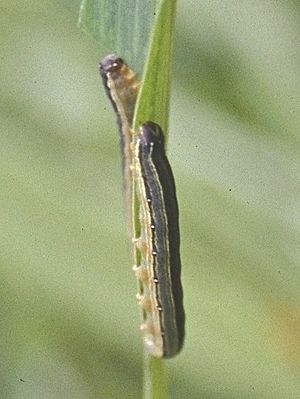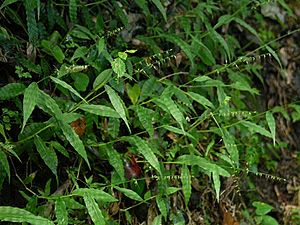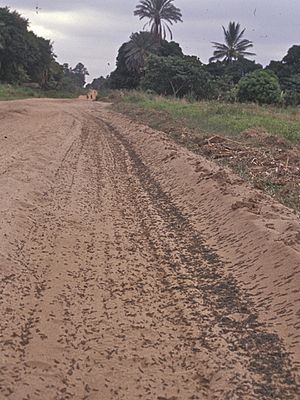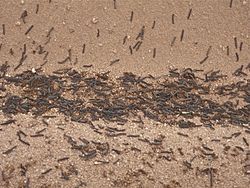African armyworm facts for kids
Quick facts for kids African armyworm |
|
|---|---|
 |
|
| Scientific classification | |
| Synonyms | |
|
The African armyworm (Spodoptera exempta) is a type of moth. It is also known by names like okalombo or kommandowurm. Its young, called caterpillars or larvae, often move in large groups. This marching behavior is why they are called "armyworms."
These caterpillars can look different depending on how many other caterpillars are around them. If they grow up alone, they are green. If they grow up in a crowd, they become black. Scientists call these phases solitaria (solitary) and gregaria (group-living). The gregaria caterpillars are a big problem for farmers. They can destroy whole fields of crops in just a few weeks. African armyworms eat all kinds of grasses. This includes young cereal crops like corn, rice, wheat, millet, and sorghum. They also eat sugarcane and sometimes even coconut plants. The solitaria caterpillars are less active and grow more slowly.
You can find African armyworms mostly in Africa. They are also seen in Yemen, some Pacific islands, and parts of Australia. When outbreaks happen, they can cause huge damage to farms and pastures. The worst outbreaks usually happen during the rainy season, especially after long periods of drought. During dry seasons, there are very few armyworms, and no outbreaks occur.
Contents
What is the African Armyworm?
The African armyworm is a species of moth. It was first described by Francis Walker in 1856. This moth belongs to a group called Spodoptera. There are about 30 known species in this group. Many of them are considered pests that harm crops.
Most Spodoptera species live in warm, tropical and subtropical areas around the world. Some species, like the African armyworm, can travel very far. Adult moths can fly hundreds of kilometers with the wind. This helps them find new places to live and lay eggs.
Where Do They Live?
African armyworms are commonly found in the grasslands of Africa and Asia. In Africa, they are often seen near the Sahara desert. This includes countries like Tanzania, Kenya, Uganda, Ethiopia, Somalia, Malawi, Zimbabwe, Zambia, and South Africa. Outside of Africa, they live in southwest Saudi Arabia, Southeast Asia, Australia, and New Zealand.
These moths prefer warm, tropical, and subtropical places. They like areas with lots of cereal crops and thick plants. This is where the young caterpillars can easily find food. During dry seasons, the adult moths might stay near coastal areas or marshes. These spots get enough rain to keep plants growing, which helps the moths survive.
What Do African Armyworms Eat?
African armyworm caterpillars eat almost only grasses. This plant family includes many important cereal crops and pasture grasses. They target most cereal crops, such as maize (corn), sorghum, rice, millet, and other grasses. Young caterpillars also eat wheat and oat seedlings.
They start by eating the top and bottom surfaces of plant leaves. They prefer to eat younger plants or those that have just sprouted. Studies show that just two caterpillars can completely eat a 10-day-old corn plant. This shows how much damage a large group of them can do.
Life Cycle of the African Armyworm
The African armyworm goes through several stages in its life.
Eggs
A female moth can lay up to 1,000 eggs in her lifetime. She usually lays 100 to 400 eggs each night. The eggs are tiny, about 0.5 mm wide. They are laid in clusters, usually on the underside of leaves. When first laid, the eggs are white. They turn black just before they hatch. The eggs hatch into larvae (caterpillars) in two to five days.
Larvae (Caterpillars)
African armyworm caterpillars go through six growth stages, called instars. This stage can last from 14 to 22 days. The time depends on the temperature and how much food is available. A fully grown caterpillar can be 25 to 33 mm long.
As mentioned, these caterpillars show two different looks. This depends on how crowded they are.
- Gregaria larvae: These caterpillars are raised in groups. They have black bodies with thin yellow stripes. They are very active and eat a lot. They also develop faster because their dark color helps them warm up in the sun.
- Solitaria larvae: These caterpillars are raised alone. They are green with a brown stripe down their backs. Their green color comes from their body and the plants they eat. They are less active and tend to stay curled up near the base of plants.
The differences in appearance become clear after the third growth stage. The darker the gregaria caterpillar, the more crowded it was. Even two caterpillars raised together can look dark brown.
Pupae
After the caterpillar stage, the armyworm turns into a pupa. This happens about 2 to 3 cm underground. They usually pupate under host plants, away from bare ground. When many caterpillars pupate at the same time, it can look like they suddenly disappear from a field.
Adults
Adult moths emerge from the pupae in 7 to 10 days. They can live for up to 14 days. These adult moths can fly hundreds of kilometers from where they hatched. They travel to new places to lay their eggs. This is why outbreaks can suddenly appear in areas that were previously clear of pests.
Even though the caterpillars look different, the adult moths from both gregaria and solitaria phases look the same. However, the gregaria caterpillars tend to become adults that fly longer distances. Adult moths have a wingspan of 20 to 37 mm. Their front wings are dull gray-brown, and their back wings are off-white with clear veins.
How Do They Migrate?
When African armyworm moths first emerge, they let their bodies dry and their wings harden. Then, they climb trees. They fly hundreds of meters high and let the wind carry them. Their migration depends on winds from the Intertropical Convergence Zone. These winds move north or south depending on the season.
The moths only travel during the day. At dusk, they fly down to hide in the grass until dawn. They repeat this for several days until they find a good spot or it rains. Rain makes the moths land, so they are less likely to migrate during frequent rainfall. Once they land, they drink water, mate, and lay their eggs. Migrating helps the species find new places with fewer predators and less risk of parasitism or disease.
Why Are They a Problem?
African armyworms are a serious pest for crops. They often thrive during the wet seasons, leading to large outbreaks. There are two types of outbreaks:
- Primary outbreaks: These start with smaller groups of armyworms that can survive without much rain.
- Secondary outbreaks: These happen when moths from a primary outbreak are carried by the wind to a new area. The adults then mate and lay eggs in that same spot.
During secondary outbreaks, many gregaria caterpillars emerge at the same time. Their numbers can be huge, sometimes over 1,000 caterpillars in just one square meter! These caterpillars eat very actively. They consume a lot of nearby plants, especially the leaves of cereal crops and grasses. If they are extremely hungry, they might even eat the stems and flowers of the plants.
When these high-density gregaria caterpillars turn into pupae and then adults, a huge group of moths migrates together. These moths then lay their eggs together, causing even more outbreaks. Outbreaks become even worse at the start of the wet season after a drought. This allows moths to lay eggs in areas with lots of plants, which helps the caterpillars grow.
What Are Their Enemies?
African armyworms have natural enemies, but these enemies often struggle to control them. This is because the armyworms migrate unpredictably and their numbers change a lot. Also, when many moths migrate at once, they can overwhelm their predators.
Still, armyworms face predators, parasites, and diseases.
- A type of virus can affect them during their pupal and pre-pupal stages.
- High humidity and temperature can lead to attacks from fungi like Nomuraea rileyi.
- The most important enemy is a specific baculovirus called S. exempta nucleopolyhedrovirus (SpexNPV). This virus can be passed from adult moths to their offspring. SpexNPV can kill up to 90% of armyworm caterpillars in their last stage of growth. The virus can travel with the infected moths during migration.
How Do Humans Deal With Them?
The gregaria phase of the African armyworm is a big problem for farming. Because it's hard to find and stop all the first outbreaks, people mainly focus on stopping the secondary outbreaks.
In the past, farmers used strong, general pesticides like DDT. Now, newer, more focused methods are used. These include natural products like azadirachtin and neem seed extracts. Scientists are also looking into using the S. exempta nucleopolyhedrovirus (SpexNPV) as a way to control them. This is called biological pest control, where a natural enemy is used to fight the pest.
Past Infestations
African armyworm outbreaks have caused serious problems in many countries:
- In April 1999, a large infestation started in southern Ethiopia. It then spread to northern Ethiopia and into Somalia. Similar outbreaks hit Kenya and Uganda at the same time.
- In January 2009, Liberia declared a state of emergency because of armyworm infestations. They consumed plants, polluted water, and moved towards neighboring countries.
- In December 2009, ten regions of Tanzania were infested. Some of these were major grain-producing areas. Farmers had been trained to fight armyworms, and pesticides were sent out. Still, thousands of acres of grain were destroyed.
- In 2015, outbreaks were reported in Zimbabwe and Botswana.
- In 2016, a different but similar armyworm, the fall armyworm (from America), invaded corn crops in Zambia. By early 2017, about 90,000 hectares were affected. The Zambian president even asked the air force to help deliver pesticides.
- In 2017, fall armyworm infestations were also found in Zimbabwe and South Africa.
Images for kids








